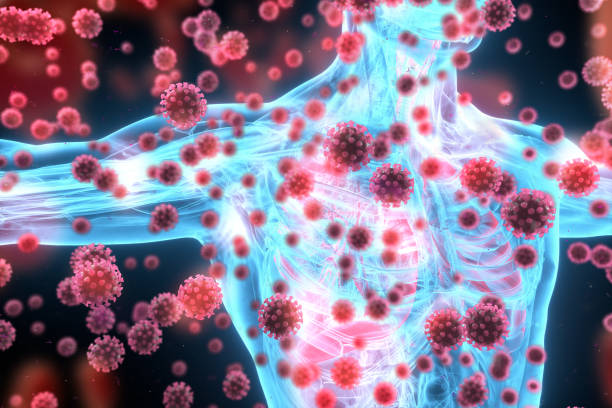Introduction
Measles remains one of the most contagious viral infections known to humanity, capable of spreading rapidly through respiratory droplets and airborne transmission. While vaccination has dramatically reduced its prevalence globally, understanding how our immune system battles this potentially serious disease is crucial for public health awareness.
The severity of measles symptoms varies widely between individuals, with immune system strength being the primary determining factor in how the infection progresses. This article explores the complex relationship between immune function and measles symptom severity, providing insights into how a robust immune response can mean the difference between a mild illness and life-threatening complications.
A strong immune system prevents severe measles symptoms primarily through four key mechanisms: rapid antibody production that neutralizes the virus before widespread infection occurs; efficient T-cell responses that eliminate infected cells; controlled inflammation that fights infection without damaging healthy tissue; and prevention of the secondary bacterial infections that cause most measles-related deaths.
The difference between mild and severe measles often comes down to how quickly your immune system recognizes and responds to the virus. When functioning optimally, your immune system can reduce viral load by up to 90% within days of activation, dramatically limiting symptom severity and preventing the virus from reaching vital organs like the lungs and brain.
Continue reading to understand exactly how your immune system fights measles, what factors might be weakening your defenses, and the specific steps you can take to strengthen immunity—whether you’re concerned about prevention or currently managing an active infection.
Understanding Measles and the Immune System
What is Measles?
Measles (rubeola) is caused by a single-stranded RNA virus belonging to the paramyxovirus family. Highly contagious, the virus initially infects the respiratory tract before spreading throughout the body via the bloodstream. The classic symptoms include high fever, cough, runny nose, red eyes, and the characteristic maculopapular rash that spreads from the face downward.
The Measles Virus Lifecycle
When the measles virus enters the body, it targets cells expressing the CD150 (SLAM) receptor, particularly dendritic cells and macrophages in the respiratory tract. The virus then uses these immune cells as vehicles to spread to lymphoid tissues, where it replicates extensively. This strategic infection of immune cells demonstrates why measles is so adept at compromising immunity.
Components of a Healthy Immune System
Our immune defense consists of two complementary systems:
- Innate Immunity: The first line of defense includes physical barriers (skin, mucous membranes), antimicrobial proteins, and cells like neutrophils, macrophages, and natural killer cells that respond immediately but non-specifically to infections.
- Adaptive Immunity: This secondary response involves specialized cells:
- B lymphocytes that produce measles-specific antibodies
- T lymphocytes that recognize and eliminate virus-infected cells
- Memory cells that provide long-term protection against future infections
Immunological Memory
After recovering from measles, the immune system retains “memory” of the virus through specialized B and T memory cells. These cells remain dormant until re-exposure, at which point they rapidly multiply and mount a swift, powerful response that typically prevents reinfection or drastically reduces symptom severity.

The Immune Response to Measles Infection
Initial Viral Recognition
The immune response begins when pattern recognition receptors (PRRs) on innate immune cells detect viral components, particularly the single-stranded RNA of the measles virus. This detection triggers the production of interferons and other antiviral molecules that establish an initial defense perimeter.
Production of Measles-Specific Antibodies
Approximately 10-14 days after infection, B cells begin producing measles-specific antibodies:
- IgM antibodies appear first, indicating acute infection
- IgG antibodies develop later and provide long-term protection
These antibodies neutralize free virus particles by binding to viral surface proteins, preventing them from attaching to and entering host cells.
T-Cell Response and Viral Clearance
While antibodies target free viruses, cytotoxic T lymphocytes (CD8+ T cells) identify and eliminate cells already infected with measles. This two-pronged approach ensures both the neutralization of circulating virus and the destruction of virus factories within the body.
Timeline of a Normal Immune Response
A healthy immune response to measles follows a predictable timeline:
- Days 1-4: Initial viral replication with minimal symptoms
- Days 5-9: Virus spreads through bloodstream; innate immune activation begins
- Days 10-14: Adaptive immunity activates; antibody production starts
- Days 14-18: T-cell response peaks; symptoms begin resolving
- Days 19-28: Recovery phase; memory cells establish long-term immunity
Cytokine Production and Regulation
The immune system produces signaling molecules called cytokines that coordinate the anti-measles response. These include:
- Interferons (IFN-α, IFN-β, IFN-γ) that create an antiviral state in surrounding cells
- Interleukins that regulate inflammation and immune cell activation
- Chemokines that attract immune cells to infection sites
A balanced cytokine response is crucial—too weak, and the virus replicates unchecked; too strong, and excessive inflammation can damage healthy tissues.

How Strong Immunity Prevents Severe Symptoms
Rapid Neutralization of Viral Particles
A robust immune system contains adequate numbers of memory B cells from previous exposure or vaccination. These cells rapidly produce high-affinity antibodies that bind to measles virions before they can infect cells, effectively reducing the initial viral burden.
Reduced Viral Load and Limited Spread
Strong immune responses maintain lower overall viral loads throughout infection. This reduced viral burden limits the spread to vital organs like the lungs, brain, and liver—preventing the most serious complications of measles including pneumonia and encephalitis.
Prevention of Secondary Bacterial Infections
Measles temporarily suppresses immune function, creating vulnerability to secondary bacterial infections. A strong baseline immune system mitigates this suppression, maintaining adequate neutrophil and macrophage function to prevent opportunistic bacteria from establishing infections in the lungs and middle ear.
Controlled Inflammatory Response
Optimal immune function ensures a balanced inflammatory response—strong enough to eliminate the virus but controlled enough to prevent tissue damage. This precise regulation prevents complications like acute respiratory distress syndrome and encephalitis that result from excessive inflammation.
Faster Recovery Time and Reduced Contagious Period
Individuals with strong immunity typically clear the virus more quickly, shortening both the duration of symptoms and the period of contagiousness. This faster resolution reduces the risk of complications and limits transmission to others.
Risk Factors for Weakened Immunity Against Measles
Malnutrition and Micronutrient Deficiencies
Nutritional status significantly impacts measles outcomes. Particularly important are:
- Vitamin A: Deficiency increases measles mortality by 50% due to impaired epithelial integrity and reduced antibody production
- Protein malnutrition: Compromises both antibody synthesis and T-cell function
- Zinc deficiency: Impairs multiple aspects of immune function, including T-cell development and cytokine production
Pre-existing Immunocompromised Conditions
Several conditions dramatically increase the risk of severe measles:
- HIV/AIDS: Depleted CD4+ T cells impair the adaptive immune response
- Cancer treatments: Chemotherapy and radiation therapy temporarily suppress bone marrow function
- Organ transplantation: Immunosuppressive medications prevent rejection but compromise viral immunity
- Primary immunodeficiency disorders: Genetic conditions affecting immune cell development or function
Age Factors
Age significantly influences measles severity:
- Infants under 12 months: Maternal antibodies have waned, but their immune systems remain immature
- Adults over 20: Often experience more severe symptoms than children, possibly due to differences in inflammatory responses
- Elderly: Immunosenescence (age-related immune decline) reduces response efficacy
Stress and Immune Function
Chronic psychological stress elevates cortisol levels, which suppress multiple aspects of immunity including:
- Reduced natural killer cell activity
- Decreased lymphocyte proliferation
- Impaired antibody production
- Altered cytokine production patterns
Sleep Deprivation Effects
Inadequate sleep compromises immune function through:
- Reduced T-cell responses
- Decreased natural killer cell activity
- Altered cytokine production favoring inflammation
- Impaired antibody response to vaccination

Building and Maintaining Strong Immunity
Nutritional Foundations for Immune Health
A balanced diet supports optimal immune function through:
- Proteins: Essential for antibody synthesis and immune cell production
- Vitamin A: Maintains mucosal barriers and supports B and T cell function
- Vitamin C: Enhances neutrophil function and supports epithelial barriers
- Vitamin D: Modulates both innate and adaptive immune responses
- Zinc: Critical for T-cell development and cytokine production
- Selenium: Supports optimal antioxidant function in immune cells
- Omega-3 fatty acids: Help regulate inflammatory responses
Exercise and Immune Surveillance
Regular moderate exercise improves immune function through:
- Enhanced circulation of immune cells throughout the body
- Temporary elevation in body temperature that may inhibit viral replication
- Reduced chronic inflammation
- Improved stress resilience
- Enhanced antibody response to vaccination
Aim for 150 minutes of moderate-intensity activity weekly, but avoid excessive high-intensity exercise, which can temporarily suppress immunity.
Sleep Hygiene for Optimal Immune Function
Quality sleep enhances immune memory and function:
- 7-9 hours nightly for adults allows for proper immune cell restoration
- Consistent sleep schedule maintains immune rhythm
- Deep sleep stages promote the release of growth hormone that supports immune cell production
- REM sleep helps consolidate immunological memory
Stress Management Techniques
Chronic stress impairs immunity, making stress management essential:
- Mindfulness meditation reduces inflammatory markers
- Deep breathing activates the parasympathetic nervous system
- Regular physical activity helps metabolize stress hormones
- Social connection provides psychological resources that buffer stress effects
Vaccination as Immune System Training
Measles vaccination:
- Trains the immune system without risking disease
- Establishes memory B and T cells specific to measles
- Provides 97% protection after two doses
- Generates herd immunity when coverage exceeds 95% of the population
Supporting the Immune System During Measles Infection
Hydration and Immune Function
Adequate hydration during measles infection:
- Maintains blood volume for efficient immune cell circulation
- Supports mucus production that traps and removes virus particles
- Helps regulate body temperature during fever
- Facilitates the removal of metabolic waste from immune responses
Nutritional Support During Active Infection
During measles, nutritional needs increase:
- Increased caloric intake: Supports the metabolic demands of immune activation
- Protein: Essential for antibody production and tissue repair
- Vitamin A supplementation: WHO recommends two doses for all children with measles
- Zinc: Supports T-cell function and may reduce duration of symptoms
- Vitamin C: Supports respiratory epithelial integrity and immune cell function
Rest and Recovery Protocols
Proper rest during measles:
- Conserves energy for immune processes
- Reduces stress hormone production
- Allows for optimal T-cell function
- Minimizes metabolic demands on the body
When to Seek Medical Intervention
Seek immediate medical care for:
- Persistent high fever (above 103°F/39.4°C)
- Difficulty breathing or rapid breathing
- Severe headache with neck stiffness
- Lethargy or confusion
- Severe dehydration (dry mouth, decreased urination)
- Ear pain (indicating possible secondary infection)
Vitamin A Supplementation Recommendations
The WHO recommends vitamin A supplementation for all children with measles:
- 50,000 IU for infants under 6 months
- 100,000 IU for infants 6-11 months
- 200,000 IU for children 12 months and older
- A second dose should be given the following day
This intervention alone has been shown to reduce measles mortality by up to 50% in populations with vitamin A deficiency.

Long-term Immunity After Measles
How the Body Develops Lasting Protection
After clearing a measles infection, the immune system establishes long-term protection through:
- Memory B cells that can rapidly produce high-affinity antibodies upon reexposure
- Memory T cells that maintain the ability to recognize and eliminate infected cells
- Long-lived plasma cells in bone marrow that continue producing antibodies for years
Cell-mediated vs. Humoral Immunity
Measles protection involves two complementary systems:
- Humoral immunity: Antibody-mediated protection that neutralizes virus before cell entry
- Cell-mediated immunity: T-cell responses that eliminate infected cells and provide cross-reactive protection
Both components are essential for comprehensive protection against severe disease.
Duration of Natural Immunity vs. Vaccine-Induced Immunity
- Natural infection: Typically confers lifelong immunity through robust memory B and T cell responses
- Vaccination: Provides strong protection for decades, though antibody levels may gradually decline
While vaccine-induced immunity may not be as absolute as natural immunity, it achieves protection without the risks of disease complications.
Herd Immunity Concept and Community Protection
When sufficient population immunity exists (>95% for measles), viral transmission chains break down, protecting:
- Infants too young to be vaccinated
- Immunocompromised individuals who cannot receive live vaccines
- Those who failed to develop immunity despite vaccination
This community protection represents one of the most effective public health interventions in history.
Conclusion
The relationship between immune system strength and measles symptom severity demonstrates the remarkable protection offered by our body’s defense mechanisms. From the initial viral recognition to the establishment of lifelong immunity, each component of the immune response plays a crucial role in determining disease outcomes. By understanding these mechanisms, we can appreciate why maintaining optimal immune function through nutrition, sleep, stress management, and vaccination provides our best defense against this highly contagious disease.
The global resurgence of measles in recent years highlights the continued importance of both individual immune health and population-level vaccination coverage. By supporting immune function while ensuring high vaccination rates, we can prevent the severe complications that once made measles a leading cause of childhood mortality worldwide.
FAQ Section
Why do some vaccinated people still get measles?
While the measles vaccine is highly effective (97% after two doses), breakthrough infections can occur for several reasons:
- Primary vaccine failure (2-3% of recipients don’t develop adequate immunity)
- Waning immunity over decades in some individuals
- Exposure to particularly high viral loads
- Underlying immune system compromise not known at vaccination
Importantly, vaccinated individuals who contract measles typically experience milder symptoms and are less likely to develop complications.
Can you boost immunity right before measles exposure?
If exposure is known, several interventions may help minimize severity:
- Ensuring vitamin A sufficiency
- Getting adequate sleep
- Reducing stress
- For unvaccinated individuals, post-exposure vaccination within 72 hours may prevent or modify disease
- Immunoglobulin administration within 6 days for high-risk individuals
However, these measures are not substitutes for pre-exposure vaccination.
How does measles affect future immune function?
Measles can cause “immune amnesia” by:
- Depleting memory B cells that provide protection against previously encountered pathogens
- Resetting the immune system, potentially erasing immunity gained from prior infections or vaccinations
- Creating increased vulnerability to other infections for months to years after recovery
This phenomenon explains the historically observed increase in childhood mortality in the years following measles outbreaks.
Are there genetic factors that influence measles immunity?
Genetic variations can influence measles susceptibility and severity:
- HLA (Human Leukocyte Antigen) variations affect how effectively viral antigens are presented to T cells
- Polymorphisms in pattern recognition receptors alter initial virus detection
- Variations in cytokine genes influence inflammatory response intensity
- Rare mutations in genes essential for interferon signaling dramatically increase susceptibility
These genetic factors explain some of the variation in symptom severity among similarly exposed individuals.
What’s the difference between measles immunity and resistance?
- Immunity: The ability to prevent infection entirely or limit it to subclinical levels through rapid recognition and neutralization
- Resistance: The capacity to control viral replication and minimize symptom severity despite established infection
Most vaccinated individuals develop true immunity, while those with partial protection may demonstrate resistance—developing infection but experiencing milder symptoms and lower transmission risks.



